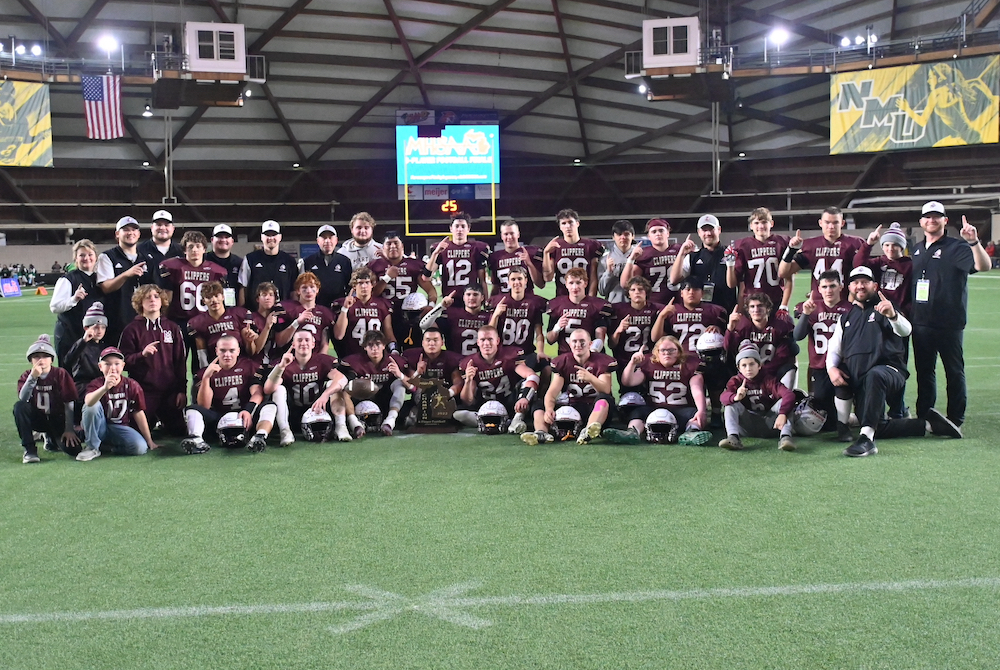
Michigan’s Football Numbers Game – Corrected
September 1, 2017
Today’s blog was written by MHSAA Second Half Editor Geoff Kimmerly
The demise of Michigan high school football has been greatly exaggerated – or, at least, recently misreported by one of the U.S.’s most recognizable newspapers that noted as part of a larger story on football decline that Michigan has seen a “net loss of 57 teams in the past five years.”
It’s easy to understand how this error took place – especially when a reporter is not familiar with the football landscape in our state – but that doesn’t make this statement any less misleading, or harmful considering the story since has been picked up by multiple large news organizations. So let’s quickly clear up the misinterpreted information:
-
The data that led to this error came from an annual participation report released by the National Federation of State High School Associations (NFHS). Every spring, state associations (like the MHSAA) from every state and Washington, D.C., tally up how many of their member schools have a sport and how many athletes play it.
-
For 2016-17, the MHSAA submitted to the NFHS a total of 580 schools with 11-player football – that number actually includes all schools that reported having at least one football player, including primary and secondary schools in co-ops. And yes, that 580 is 57 fewer than the 637 11-player schools the MHSAA submitted for 2012-13.
-
But saying Michigan has lost 57 football programs misses out on something incredibly significant – the MHSAA also submitted 60 schools with 8-player football last year, up from 16 in 2012-13, making that net decrease in football schools over five years 13 – far fewer than 57.
And with a few more brush strokes, the picture of football in our state actually shows a healthy landscape:
-
The 640 schools in Michigan with at least one football player for 2016-17, 11 and 8-player combined, is actually eight more than we reported to the NFHS four years ago and 10 more than three years ago.
-
A better picture of Michigan’s football consistency is shown by how many varsity programs are taking the field. This fall, that number is 616 – 555 11-player varsities and 61 8-player – and we also had 616 for most of the 2016 season, 616 in 2015 and 615 in 2014.
-
We’ve had programs bring back varsity teams this year, and in one case a school has a team on its own for the first time. Benzonia Benzie Central and Suttons Bay were unable to field varsities in 2016, but Benzie Central is back playing 11-player and Suttons Bay is back with an 8-player team. Brimley, an 8-player school going back to 2010, also is fielding a team again after being unable to do so last year. Mount Clemens played only two varsity games in 2016 and forfeited a third, but has seven scheduled for this fall and lost close in its opener last week. And Bear Lake, previously a secondary school in a co-op program, now has a team all its own for the first time and is playing at the 8-player level.
-
Yes, there has been a decrease in Michigan high school football participation when it comes to the number of players – for reasons we discuss frequently, including more extracurricular/entertainment options than ever for students, more who are specializing in other sports and safety fears that often are misplaced. But we’ve also seen a three percent drop in enrollment at MHSAA member schools over the last five years. And despite that trend, Michigan again had the sixth-highest 11-player football participation in the nation in 2016-17 (and seventh-highest in 8-player) while ranking 10th nationally in number of residents of high school age.
-
So yes, while a nine percent drop in the number of football players over the last five years in Michigan clearly is troubling, and something we’re working with the Michigan High School Football Coaches Association to reverse, let’s also put those numbers in perspective. At medium-sized to bigger schools, it could mean a roster of 40 might have only 36 players. A roster of 20 at an 8-player school might go down to 18. Neither would signal the need to eliminate a football program.
-
And that move by so many schools to 8-player? It definitely started as a way for low-participation programs to keep football (and has worked for most of them). While that still may be the driving force as schools move from 11 to 8, others have made the switch because most of their former opponents did and joining them makes scheduling easier and travel shorter. Michigan has a multitude of small towns, and you’ll find most of these 8-player programs in pockets in the thumb, southwest or northern Lower Peninsula, or Upper Peninsula. And keep in mind, only Class D teams remain eligible for the 8-player playoffs – and only two of 61 teams playing 8-player this fall are larger than Class D and its enrollment limit of 203 students for 2017-18.
The story behind “a decrease of 57 schools” clearly is a little complex to explain and explain away, but it’s necessary to do so.
Yes, Michigan’s total number of football players is down a few percent. But the sport’s prominence and importance in our schools and communities remains high.

Team of the Month: Martin Football
By
Geoff Kimmerly
MHSAA.com senior editor
December 13, 2022
Two straight trips to 8-Player Semifinals
 Two seasons over the last three with double-digit wins.
Two seasons over the last three with double-digit wins.
Three straight seasons where the only loss on the field came in the playoffs to the eventual Division 1 champion.
Martin’s football team had come so close a few times to earning the ultimate prize in Michigan high school football. And finally, this fall, it was the Clippers’ turn.
Paced by 11 seniors, the MHSAA/Applebee’s “Team of the Month” for November claimed the 8-Player Division 1 championship at the Superior Dome in Marquette – the Clippers’ first Finals title since 1987 – with a 74-24 win over previously-undefeated Merrill.
“This is the most seniors we’ve ever had, as long as I’ve been coaching here,” said Martin coach Brad Blauvelt, a 2003 graduate of the school who just finished his fifth season leading the program after serving as an assistant coach nearly as long before taking over. “Program kids – from rocket football to middle school, all the way up, they’ve been committed to the program the whole time.”
Martin has an interesting recent history as a program, to say the least. After five straight winning seasons from 2003-07, the Clippers didn’t win a game from 2008-2013. They got back on the plus side at 6-4 in 2018, then made the move to 8-player – where they’ve gone a combined 40-6 over the last four seasons.
This one started with a 30-28 win over Mendon – the eventual 8-Player Division 2 runner-up – and over 13 games Martin averaged 54 points while giving up only 14.5. There were a pair of losses along the way – to Grand Rapids NorthPointe Christian and Bridgman, which both finished 9-0 but have enrollments too high to qualify for the 8-Player Playoffs. Those losses helped Martin move forward, especially the 35-34 defeat against Bridgman in the regular-season finale.
“The biggest thing was being OK with a loss, because we were so used to winning … not being OK with it, just understanding we’ll get better from it,” Blauvelt said.
The Bees were able to get their playmakers outside on the Clippers – which generally means big plays in the 8-player format. So Martin’s coaches made a sharp adjustment heading into the postseason, putting all-state safety Sam Jager at one outside linebacker, and moving middle linebacker (and all-state quarterback) JR Hildebrand outside on the other side.
So while Hildebrand was able to continue leading the offense to totals of 68, 56, 42 and 74 points over the four playoff games, the Clippers during the playoffs gave up just 52 points total – and held a two-time reigning champion Adrian Lenawee Christian team averaging 48 points per game to just 14 in a 59-14 Regional Final win.
The Cougars had eliminated Martin from the playoffs the last two Semifinals on the way to those two straight Division 1 championships. In 2019, Martin lost to Colon in a Regional Final, and the Magi went on to claim the Division 1 title.
“The last couple of years, we lost the last game of the season, and you can’t do anything about it,” Blauvelt said. “Losing in-season, we were able to fix and change some things around that I think ultimately helped us.”
Hildebrand was one of the state’s best at his position this fall, rushing for 1,340 yards and 23 touchdowns and throwing for 1,234 yards and 25 scores. He owns two school records on offense, and also led the team with 90 tackles, to go with four sacks and seven more tackles for loss.
Jager caught seven of those touchdown passes and was the best blocker for a team that ran for more than 2,600 yards. He had 51 tackles and five interceptions, including one he brought back for a score. Another senior, Karter Ribble, topped 300 yards rushing and receiving, with a combined 12 touchdowns, plus scored twice on kickoffs and again on a punt return. He also made 90 percent of his extra-point tries and set a school record with a 43-yard field goal.
They were part of that senior class that, although graduating, has helped bring a buzz and momentum that Blauvelt hopes carries over into other sports, academics and the community as a whole.
“They come to morning workouts, they come to all the summer stuff, and they do the extra work to push themselves over the hump,” Blauvelt said. “They’re so talented athletically too, that doing that pushed them over the top even more so.”
Past Teams of the Month, 2022-23
October: Gladwin volleyball - Report
September: Negaunee girls tennis - Report

